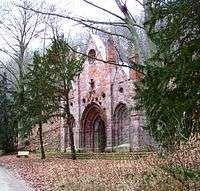House of Asseburg



The House of Asseburg, original German name von der Asseburg, are an old Lower Saxon aristocratic family, which has its seat in the eponymous castle of Asseburg. Today, however, the castle on the Asse near Wolfenbüttel only survives as ruins.
History
Originally the family called itself Wolfenbüttel, its first member, Widekind of Wolfenbüttel, also known as Widekindus de Wolferbutle, being mentioned in the records between the years 1089 to 1118. As a ministerialis for Margrave Egbert II of Meißen and Brunswick he had a very influential position, so that he was able to provide surety for his lord to Emperor Henry IV amongst others. His great-grandson Gunzlin of Wolfenbüttel (1187 – 1255) was an imperial seneschal (Reichstruchsess) and gained importance as an Army commander and statesman to two emperors, the Welf, Otto IV and the Hohenstaufen, Frederick II. As a Hohenstaufen advisor, he was no longer safe in his Welf-Wolfenbüttel estates, so in 1218 he built the castle of Asseburg, south of Wolfenbüttel. Burchardus de Asseburc (Burchard of Asseburg) is mentioned in 1219, the first time anyone is named after the new family seat of Asseburg. But as early as 1258 the castle had to be relinquished to Duke Albert of Brunswick. From the middle of the 13th century two lines emerged: an older Eastphalian - Thuringian line and a younger Westphalian line. The former was initially established at Moringen Castle near Northeim, later also at Neindorf and Ampfurth. In 1437, Falkenstein Castle in the Lower Harz was acquired by the family as an enfeoffment of the bishops of Halberstadt.. In 1509, Wallhausen was also acquired, initially as an enfeoffment of the County of Mansfeld, later of the Electorate of Saxony The younger Westphalian line was based at the castle of Hinnenburg near Brakel, which it had inherited with other estates by marriage to the lords of Brakel. This younger line died out in the 16th century and was succeeded by the older line. From this, in the 17th century, a new Westphalian branch emerged, from which William Anthony of the Asseburg (1707 – 1782) was appointed as Bishop of Paderborn (from 1763 to 1782).
A short time later, the male line of this Westphalian branch of the Asseburgs died out. The name was perpetuated, however, by the marriage in 1793 of their heiress to the House of Bocholtz, who, from 1803, became the counts of Bocholtz-Asseburg.
The Eastphalian-Thuringian Asseburg's branch of Ampfurth-Falkenstein were granted the title of count in 1840 and were able to inherit the title under the rules of primogeniture as the Counts of Asseburg-Falkenstein. The Westphalian line bore the title Baron (Freiherr) under customary law, other branches under patent from the year 1747.

Coat of arms
The family coat of arms depicts a black wolf couchant on a gold field. On the crowned helm is a red column with an embedded gold mirror, bedecked with nine natural peacock feathers. The mantling is black and gold.
Members
- Achatz Ferdinand von der Asseburg (1721 –1797), diplomat
- Anna, Countess of the Asseburg (1830–1905), ruler of the Barony of Neudek
- Frederick von der Asseburg (Teutonic Knight) (Frederick von der Asseburg auf Hindenburg; † 1704), knight of the Teutonic Order
- Frederick, Count of the Asseburg (1861–1940), Prussian officer and chamberlain (‘’Kammerherr’’)
- Gunzelin von Wolfenbüttel (also Gunzelin of the Asseburg) (ca. 1170–1255), ministerialis from the line of Wolfenbüttel-Asseburg
- Herman Werner von der Asseburg (1702–1779), leading minister in the Electorate of Cologne
- Louis, Count of the Asseburg (1796 –1869), lord of the minor county (‘’Mindergrafschaft’’) of Falkenstein
- Moritz William von der Asseburg (1698 –1780), Prussian major general
- Rosamunde Juliane von der Asseburg (1672 –1712), visionary and prophetess of the early pietism
- Widekind of Wolfenbüttel (after 1089–ca. 1118), built the water castle of Wolfenbüttel and founded the line of Wolfenbüttel-Asseburg
- William Anton von der Asseburg (1707 –1782), Prince-bishop of Paderborn
Literature
- Johann Bernhard Count von Bocholtz-Asseburg: Asseburger Urkundenbuch. 3 volumes, Hanover 1876, 1887 and 1905. (Neudruck: Wenner, Osnabrück 1975, ISBN 3-87898-164-3)
- Genealogisches Handbuch des Adels, Adelslexikon Vol. I, Part 53 of the whole range, C. A. Starke Verlag, Limburg (Lahn), 1972, ISSN 0435-2408
- Otto Hupp: Münchener Kalender 1923. Buch u. Kunstdruckerei, Munich/ Regensburg, 1923.
- Ernst Heinrich Kneschke: Neues allgemeines deutsches Adels-Lexicon. Vol. 1, Frederick Voigt's Buchhandlung, Leipzig 1859, p. 127. (digitalised)
- Leopold von Zedlitz-Neukirch: Neues preussisches Adelslexicon. Vol. 1, Gebrüder Reichenbach, Leipzig, 1836, p. 147. (digitalised)
- Leopold von Zedlitz-Neukirch: Neues preussisches Adelslexicon. Supplement – Vol. 2, Gebrüder Reichenbach, Leipzig, 1843, p. 5. (digitalised)
External links
- Historic registers from the archives of Hinnenburg Castle / Digital Westphalian Document Data Bank (DWUD)
- Von der Asseburg family in the castle archives at Wildenfels

.jpg)